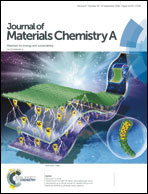Thermal stability of Mg3Sb1.475Bi0.475Te0.05 high performance n-type thermoelectric investigated through powder X-ray diffraction and pair distribution function analysis†
Abstract
Cheap and non-toxic n-type Mg3Sb2 based materials exhibit outstanding thermoelectric properties, but for actual applications it is essential to scrutinize their behavior under high temperature conditions. Here, powder samples of nominal composition Mg3Sb1.475Bi0.475Te0.05 have been subjected to repeated thermal cycling in the temperature range of 300–725 K, while measuring separate synchrotron powder X-ray diffraction and X-ray total scattering data. Approximately 11 wt% elemental bismuth crystallizes as a secondary phase after the first thermal cycle, but the evolution stagnates at approximately 15 wt% after the 10th thermal cycle. A significant decrease is found in the unit cell parameter of the Mg3Sb1.475Bi0.475Te0.05 phase after the first thermal cycle, indicating that bismuth release from the crystal structure. This is corroborated by the total scattering data, which do not detect an initial amorphous bismuth phase. In addition, STEM-EDS reveal a homogeneous distribution of antimony and bismuth in the as-synthesized particles, while a clear growth of pure bismuth is observed in a sample having been annealed at 725 K for one hour.



 Please wait while we load your content...
Please wait while we load your content...